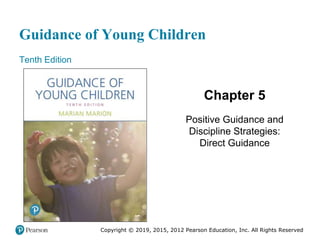The chapter discusses positive guidance and discipline strategies for working with young children. It defines key concepts like guidance, discipline, and punishment. Several major positive guidance strategies are described for redirecting inappropriate behaviors, such as teaching helpful behaviors, setting up practice sessions, giving cues, changing contexts, ignoring minor behaviors, redirecting and distracting young children, making substitutions for older children, active listening, using I-messages, teaching conflict resolution, preventing overstimulation, and helping children save face. The strategies focus on teaching and guiding behavior rather than punishment.

























